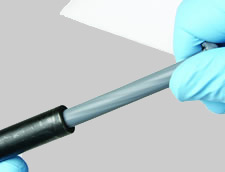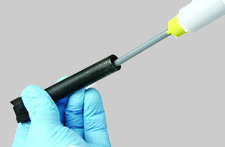Home | Glossary | Resources | Help | Contact Us | Course Map
Archival Notice
This is an archive page that is no longer being updated. It may contain outdated information and links may no longer function as originally intended.
Test Firing
Laboratory policies and procedures should be followed for test firing. If there are any concerns about the safety of the firearm, a remote firing system should be used.
The following is a general description of the process to be performed and documented for function and bullet recovery test firing:
- Function.
- Load firearm with one cartridge.
- Announce intention to fire.
- Discharge firearm.
- Bullet recovery.
- Properly mark cartridge case and bullets.
- Determine appropriate recovery medium (water, cotton, etc.).
- Load firearm with one marked cartridge.
- Place the firearm into the recovery system firing opening.
- Announce intention to fire.
- Discharge the firearm.
- Repeat steps c f until number of test fires required (by laboratory policy) is complete.
- Recover bullets and cartridge cases.
- Additional Testing.
- Full automatic firing.
- Single-action.
- Double-action operation.
| Note: |
| When testing for firearm function of semiautomatic pistols and full automatic firearms, more than one cartridge should be used. Laboratory protocol should be followed for this functionality testing. |
| Special Considerations | |
|
Revolvers |
In double-action revolvers with the capability of operating in single- or double-action mode, test fires should be obtained using both modes; markings may vary depending on the mode of discharge. |
|
Multi-barreled firearms |
In multibarrel firearms, each barrel must be test fired; marked bullets/cartridges must be readily identifiable back to the barrel and breech that discharged them. |
|
Rifles |
High-powered rifles can present difficulties in the recovery of fired bullets due to potential bullet fragmentation. Refer to laboratory policy for the correct methodology. |
|
Firearms unsafe to discharge |
Using casting material, cast the barrel or the breech face firing area to provide microscopic detail for examination and comparison. |
Read more on casting in Module 11.
Drop Testing
When firearms submitted to the crime laboratory are involved in an alleged accidental discharge case, a special test may be required. If a defect is not discovered during the basic examination that supports an accidental discharge, an additional test, called the drop test is performed.
This test enables the examiner to determine if there is a possibility the firearm will discharge if dropped. This is a time-consuming examination, which has potential to damage the tested firearm. Therefore, when necessary it should be the last examination conducted.
The results of the following drop test examination should be documented:
- Place a one-inch-thick rubber pad onto a solid floor (such as concrete).
- Place a primed cartridge case in the chamber that will receive the hammer strike.
- Cock the firearm.
- Disengage the external safety.
- Drop the firearm from a height of about three feet onto the pad.
- Test all positions of the firearm - top, bottom, left side, right side, rear, and muzzle. (Before each drop, the primed case should be checked for firing pin indentations and the findings recorded.)
There are two possible outcomes:
- The primed case does not detonate, indicating that the firearm will not discharge when dropped.
- The primed case detonates:
- Field strip the firearm.
- Examine the major internal components to determine if there are any broken or missing parts.
Shock Test
A modification of the drop test can be conducted using a dead blow hammer. The shock test is performed as outlined for the drop test with one exception. Instead of dropping the firearm onto the rubber mat, the firearm is struck with the dead blow hammer.
| The following applies to both drop testing and shock testing: |
|
Selected Bibliography
The Selected Bibliography is a list of the writings that have been used in the assemblage of the training program and is not a complete record of all the works and sources consulted. It is a compilation of the substance and range of readings and extensive experience of the subject matter experts.
- Burrard, G. 1962. The Identification of Firearms and Forensic Ballistics . New York: A.S. Barnes & Co.
- Chenow, R.W. 1987. Conversion of the Intratec Tec 9 to full auto. AFTE J 19 (2): 169-171.
- Conrad, W.E. 1980. Firing pistol ammunition in a revolver. AFTE J 12 (1): 33.
- Davis, J.E. 1958. Introduction to Tool Marks, Firearms and the Striagr . Springfield: Charles C Thomas Pub Ltd.
- Gunther, J.D., and C.O. Gunther. 1935. The Identification of Firearms . New York: John Wiley and Sons Inc.
- Hatcher, J. 1935. Textbook of Firearms Investigation, Identification and Evidence . Plantersville: Small-Arms Technical Publishing Co.
- Hatcher, J. 1947. Hatchers Notebook . Harrisburg: Military Service Publishing Co.
- Hatcher, J.S., F.J. Jury. and J. Weller. 1957. Firearms Investigation, Identification, and Evidence . Harrisburg: Stackpole Books.
- Heard, B. 1997. Handbook of Firearms and Ballistics - Examining and Interpreting Forensic Evidence . West Sussex: John Wiley & Sons, Inc.
- Koffman, A., A. Zeichner, B. Glattstein, and T. Kahana. 2002. Firearms report paper 1998 2001. AFTE J 34 (4): 409-436.
- Laskowski, G.E. 1995. Full auto conversion of an UZI 9mm semiautomatic pistol. AFTE J 27 (4): 287-292.
- Lipscomb, J.W., and L.R. Harden. 1985. Evaluating trigger mechanisms for sensitivity to shock. AFTE J 15 (4): 4.
- Love, E.W. 1978. Full automatic AR-15 rifle. AFTE J 10 (2): 46.
- Mathews, J.H. 1962. Firearms Identification, Volume I . Springfield: Charles C. Thomas.
- Mathews, J.H. 1962. Firearms Identification, Volume II . Springfield: Charles C. Thomas.
- Mathews, J.H. 1973. Firearms Identification, Volume III . Springfield: Charles C. Thomas.
- Mogish, N.M. 1990. Full auto Uzi conversion. AFTE J 22 (2): 186-187.
- National Rifle Association. 1989. NRA Firearms Fact Book . 3rd Edition. Fairfax: National Rifle Association.
- Phillips, G.R. 1983. Ruger security six revolver for accidental discharge. AFTE J 15 (4): 56.
- Thompson, R.C. 1983. Firearms malfunction worksheets. AFTE J 15 (1): 100.
- Uri, B. 1993. Remote controlled device for safe discharge of dangerous firearms. AFTE J 25 (2):116-124.
- Wolslagel, P.F. 2001. Accidental discharge potential of Lorcin, Bryco, and related pistols. AFTE J 33 (1): 48-49.
- Zahn, M.S. 1981. Browning Hi Power automatic pistol: Another type of full automatic modification. AFTE J 13 (2): 24.
Additional Online Courses
- What Every First Responding Officer Should Know About DNA Evidence
- Collecting DNA Evidence at Property Crime Scenes
- DNA – A Prosecutor’s Practice Notebook
- Crime Scene and DNA Basics
- Laboratory Safety Programs
- DNA Amplification
- Population Genetics and Statistics
- Non-STR DNA Markers: SNPs, Y-STRs, LCN and mtDNA
- Firearms Examiner Training
- Forensic DNA Education for Law Enforcement Decisionmakers
- What Every Investigator and Evidence Technician Should Know About DNA Evidence
- Principles of Forensic DNA for Officers of the Court
- Law 101: Legal Guide for the Forensic Expert
- Laboratory Orientation and Testing of Body Fluids and Tissues
- DNA Extraction and Quantitation
- STR Data Analysis and Interpretation
- Communication Skills, Report Writing, and Courtroom Testimony
- Español for Law Enforcement
- Amplified DNA Product Separation for Forensic Analysts




